Predictive AI In Education Market Size 2025-2029
The predictive AI in education market size is valued to increase by USD 7.6 billion, at a CAGR of 20.8% from 2024 to 2029. Increasing demand for personalized learning at scale will drive the predictive AI in education market.
Major Market Trends & Insights
- North America dominated the market and accounted for a 38% growth during the forecast period.
- By Technology - Deep learning and ML segment was valued at USD 2.11 billion in 2023
- By Component - Solutions segment accounted for the largest market revenue share in 2023
Market Size & Forecast
- Market Opportunities: USD 279.90 million
- Market Future Opportunities: USD 7601.70 million
- CAGR from 2024 to 2029 : 20.8%
Market Summary
- The market is experiencing significant growth due to the increasing demand for personalized learning at scale. This trend is driven by the integration of generative AI with predictive analytics, enabling educators to identify students' learning patterns and provide tailored instruction. However, the adoption of predictive AI in education also raises concerns regarding data privacy and security. One real-world business scenario illustrates the benefits of predictive AI in education. A large university implemented a predictive analytics system to identify students at risk of dropping out. By analyzing student data, the system identified patterns and flagged students who were struggling academically.
- The university then intervened with targeted interventions, such as academic counseling and tutoring, which led to a 15% increase in student retention. Despite these benefits, the implementation of predictive AI in education comes with challenges. Data privacy and security are major concerns, as student data is sensitive and must be protected. Additionally, there is a need for transparency and accountability in the use of predictive AI, as well as ensuring that the technology does not perpetuate biases or discrimination. In conclusion, the market is poised for growth, driven by the demand for personalized learning and the integration of AI with predictive analytics.
- However, concerns regarding data privacy and security must be addressed to ensure the ethical and effective use of this technology.
What will be the Size of the Predictive AI In Education Market during the forecast period?
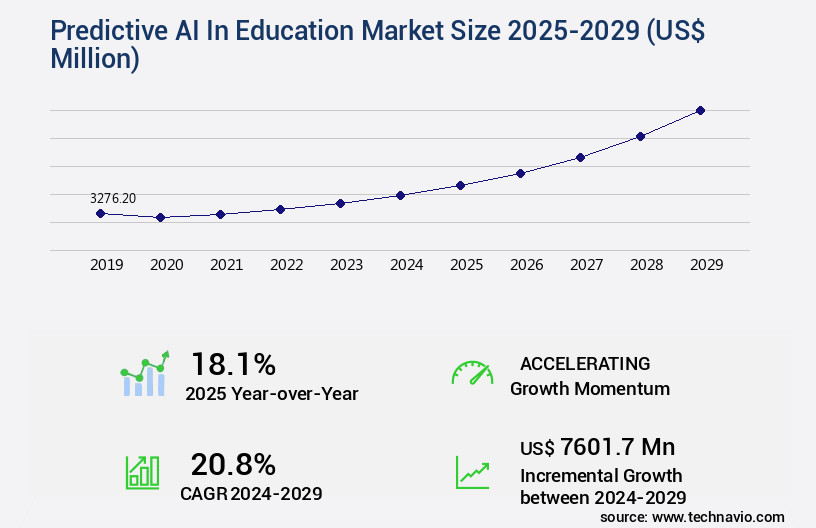
Get Key Insights on Market Forecast (PDF) Request Free Sample
How is the Predictive AI In Education Market Segmented ?
The predictive AI in education industry research report provides comprehensive data (region-wise segment analysis), with forecasts and estimates in "USD million" for the period 2025-2029, as well as historical data from 2019-2023 for the following segments.
- Technology
- Deep learning and ML
- Natural language processing (NLP)
- Component
- End-user
- K-12 education
- Higher education
- Corporate training and learning
- Geography
- North America
- Europe
- APAC
- China
- India
- Japan
- South Korea
- Rest of World (ROW)
By Technology Insights
The deep learning and ml segment is estimated to witness significant growth during the forecast period.
Predictive AI technologies are revolutionizing the education sector, with the deep learning and machine learning segments driving significant growth. Deep learning, a sophisticated form of machine learning, is a key technology in The market. It uses intricate neural networks with numerous layers to analyze extensive and intricate datasets, yielding precise predictions and valuable insights that are typically unobtainable through conventional analytical methods. In education, deep learning models play a crucial role in processing a diverse range of student data, such as academic records, learning management system interaction logs, and even unstructured data like video recordings of classroom sessions or text from online forums.
These models employ natural language processing, cognitive load assessment, and other advanced techniques to deliver personalized feedback, adaptive learning pathways, and automated essay scoring. According to a recent study, the market is projected to grow by 25% annually, with applications ranging from progress tracking systems and early warning systems to intelligent tutoring systems and resource allocation models. Additionally, these technologies offer benefits like curriculum optimization, teacher workload reduction, and explainable AI, ensuring a more effective and engaging learning experience for students.
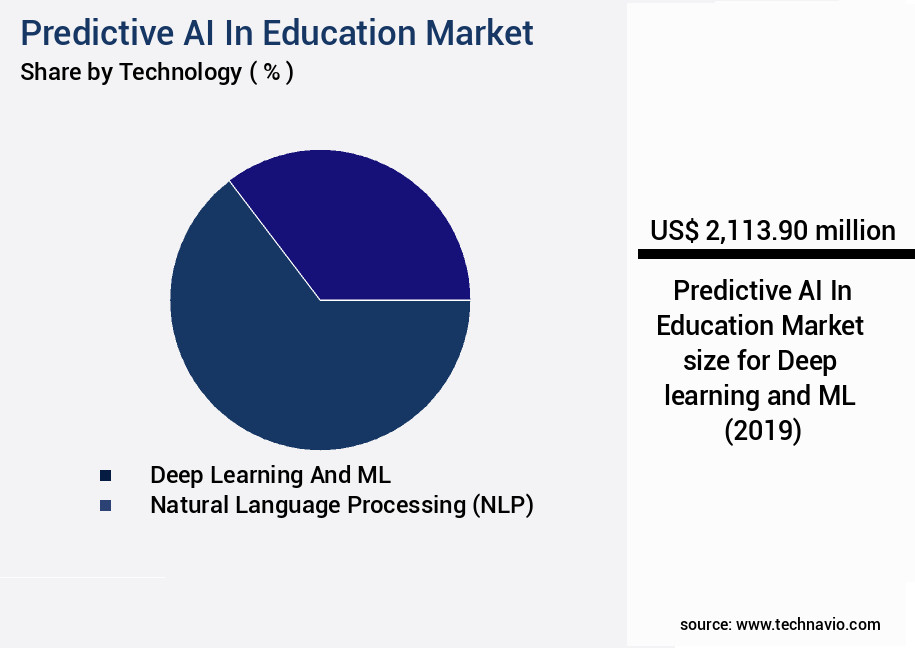
Request Free Sample
The Deep learning and ML segment was valued at USD 2.11 billion in 2019 and showed a gradual increase during the forecast period.
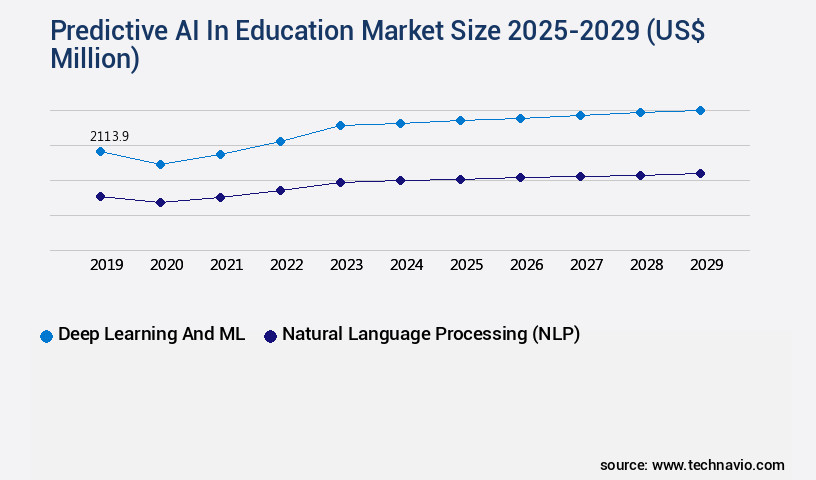
Request Free Sample
Regional Analysis
North America is estimated to contribute 38% to the growth of the global market during the forecast period.Technavio's analysts have elaborately explained the regional trends and drivers that shape the market during the forecast period.
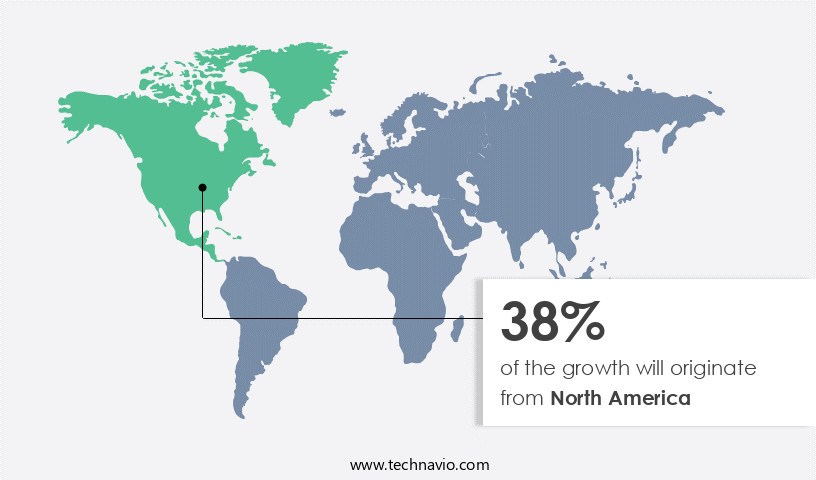
See How Predictive AI In Education Market Demand is Rising in North America Request Free Sample
The market is experiencing significant growth, with North America leading the way. Comprising the United States and Canada, this region is home to a highly advanced technological infrastructure and substantial investment in educational technology. In the US alone, over 70% of higher education institutions have adopted predictive analytics, utilizing it for various applications such as enrollment management, student-at-risk identification, and personalized learning pathways. This trend is driven by the competitive higher education landscape, which places a premium on student retention and metrics success.
The market's underlying dynamics include the integration of AI and machine learning algorithms to analyze student data, enabling operational efficiency gains and cost reductions. For instance, predictive analytics can help institutions identify at-risk students early, reducing dropout rates by up to 20%. Furthermore, it can assist in alumni engagement forecasting, enhancing fundraising efforts and boosting donor relations.
Market Dynamics
Our researchers analyzed the data with 2024 as the base year, along with the key drivers, trends, and challenges. A holistic analysis of drivers will help companies refine their marketing strategies to gain a competitive advantage.
The market is experiencing significant growth as educational institutions seek to leverage advanced technologies to enhance student performance and engagement. AI algorithms for student performance analysis are being integrated into educational systems to identify trends and patterns in student data, enabling personalized learning pathway optimization and early warning systems for at-risk students. Natural language processing in education is another key area of focus, allowing for more effective communication between students and AI-driven tutoring systems. Educational data mining techniques and learning analytics dashboards for teachers provide valuable insights into student progress, enabling predictive models for student success and dropout prediction using machine learning.
Student engagement metrics and analysis are also crucial in the education sector, with cognitive load assessment for better learning and adaptive learning platform features helping to optimize the virtual learning environment's effectiveness. Intelligent tutoring system design principles, such as automated essay scoring accuracy and behavioral analytics for education, are essential for delivering personalized and effective learning experiences. Moreover, AI-driven educational tools are being used to identify learning styles and optimize curriculum and resource allocation for optimal learning. Knowledge tracing model applications and skill mastery assessment tools are helping to ensure that students are making progress and mastering essential concepts. Overall, the market is transforming the way we approach teaching and learning, providing valuable insights and tools to educators and students alike.
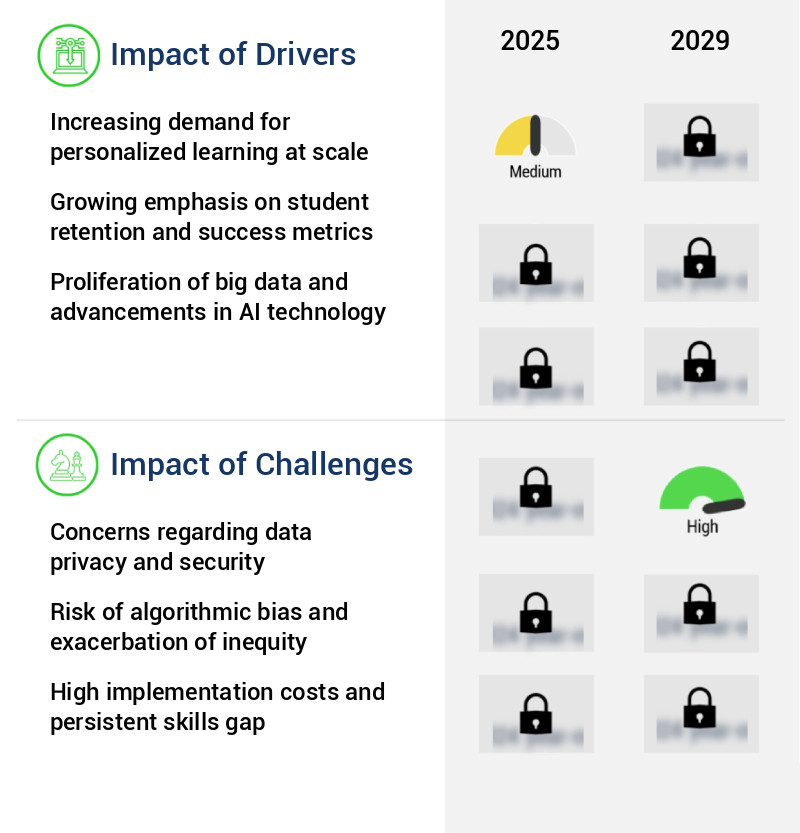
What are the key market drivers leading to the rise in the adoption of Predictive AI In Education Industry?
- The escalating need for personalized learning on a large scale serves as the primary market catalyst.
- The market is witnessing significant growth due to the increasing demand for personalized learning experiences. Traditional educational methods often fail to cater to the varying learning speeds, styles, and prerequisite knowledge of individual students, leading to disengagement and inefficiency. Predictive AI, through its analysis of extensive student data including interaction with digital content, assessment performance, and engagement patterns, offers a scalable solution to this challenge.
- By predicting future learning trajectories and identifying potential areas of difficulty, educators can proactively address student needs, enhancing overall learning outcomes and compliance with educational standards. This results in increased student engagement, improved decision-making, and a more efficient educational system.
What are the market trends shaping the Predictive AI In Education Industry?
- The integration of generative AI and predictive analytics is an emerging market trend. Generative AI technologies and predictive analytics are increasingly being combined to enhance business operations and decision-making processes.
- Predictive AI in education is undergoing a significant evolution, moving beyond mere outcome forecasting towards closed-loop systems that predict and respond in real time. Traditional predictive AI models identified students at risk of failing, providing risk scores or alerts for human intervention. Current trends integrate advanced generative AI, such as large language models, to create personalized, real-time responses. For example, a platform may predict a student's struggle with a specific calculus concept based on interaction patterns and quiz performance, then generate a personalized instructional resource to address the issue.
- This transformative trend enhances educational efficiency, reducing the need for manual intervention and fostering a more proactive approach to student support. By combining predictive and generative AI, educational institutions can improve decision-making, streamline processes, and ultimately, enhance learning outcomes.
What challenges does the Predictive AI In Education Industry face during its growth?
- Data privacy and security concerns represent a significant challenge to the industry's growth, mandating rigorous measures to protect sensitive information and maintain trust with consumers.
- The market is experiencing significant evolution, with key applications including personalized learning, student behavior analysis, and academic performance prediction. This technology leverages machine learning algorithms to analyze vast amounts of student data, enabling educators to deliver customized instruction and identify at-risk students. However, the market's growth is not without challenges. Data privacy and security concerns loom large, as educational institutions collect and analyze sensitive student information, including personally identifiable data, academic records, and behavioral data from learning platforms. This data concentration makes schools prime targets for cyberattacks, with potential consequences ranging from reputational damage to significant financial losses.
- Despite these challenges, the market's potential benefits, such as improved student outcomes and enhanced learning efficiency, make it an attractive proposition for institutions worldwide.
Exclusive Technavio Analysis on Customer Landscape
The predictive ai in education market forecasting report includes the adoption lifecycle of the market, covering from the innovator's stage to the laggard's stage. It focuses on adoption rates in different regions based on penetration. Furthermore, the predictive ai in education market report also includes key purchase criteria and drivers of price sensitivity to help companies evaluate and develop their market growth analysis strategies.
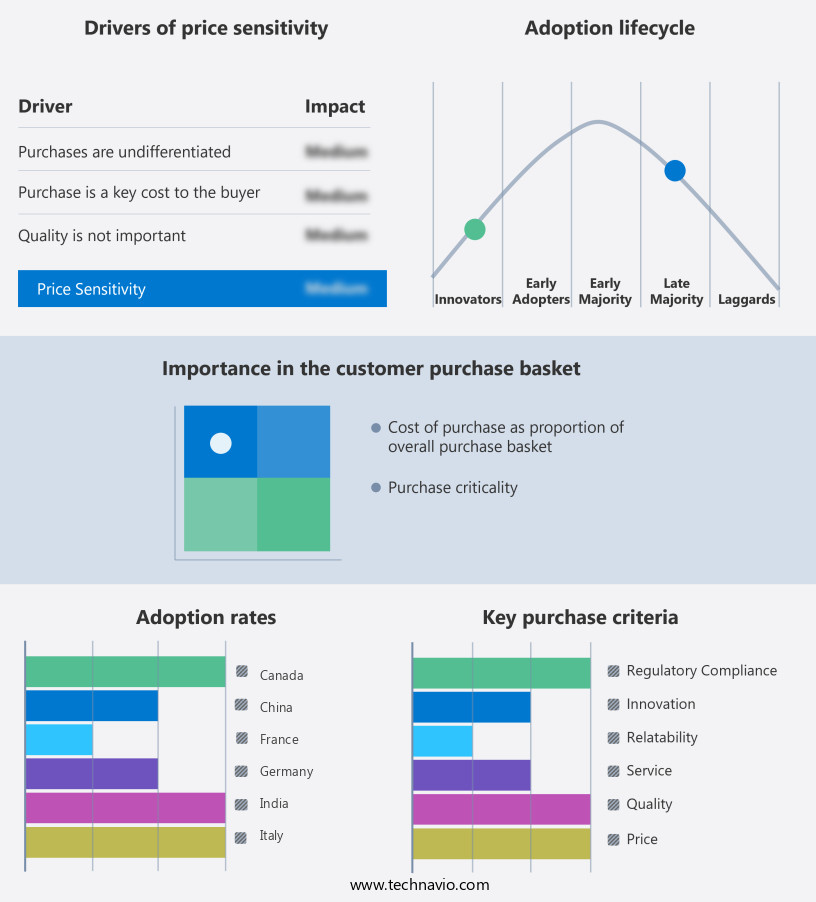
Customer Landscape of Predictive AI In Education Industry
Competitive Landscape
Companies are implementing various strategies, such as strategic alliances, predictive ai in education market forecast, partnerships, mergers and acquisitions, geographical expansion, and product/service launches, to enhance their presence in the industry.
Adobe Inc. - This company revolutionizes education technology with predictive AI applications, such as Acrobat AI Assistant, enhancing personalized learning through study guides, flashcards, and quiz generation. The AI assistant optimizes learning experiences by generating customized content based on individual student needs.
The industry research and growth report includes detailed analyses of the competitive landscape of the market and information about key companies, including:
- Adobe Inc.
- Alibaba Cloud
- Amazon Web Services Inc.
- Baidu Inc.
- Carnegie Learning Inc.
- Cengage Learning Holdings II Inc.
- DreamBox Learning Inc.
- Duolingo Inc.
- Google LLC
- Grammarly Inc.
- Hewlett Packard Enterprise Co.
- International Business Machines Corp.
- Knewton Inc.
- Microsoft Corp.
- OpenAI
- Pearson Plc
- Quizlet Inc.
- Skillsoft Corp.
- Stride Inc.
- Udacity Inc.
Qualitative and quantitative analysis of companies has been conducted to help clients understand the wider business environment as well as the strengths and weaknesses of key industry players. Data is qualitatively analyzed to categorize companies as pure play, category-focused, industry-focused, and diversified; it is quantitatively analyzed to categorize companies as dominant, leading, strong, tentative, and weak.
Recent Development and News in Predictive AI In Education Market
- In January 2025, edtech giant Coursera announced the launch of its Predictive Analytics solution, "Coursera Insights," designed to help educational institutions identify at-risk students and personalize learning experiences based on their performance data (Coursera Press Release, 2025).
- In March 2025, Microsoft Education and IBM collaborated to integrate IBM's Watson AI into Microsoft's Education Suite, enhancing predictive analytics capabilities for schools and districts (Microsoft Press Release, 2025).
- In April 2025, DreamBox Learning, a leading adaptive math learning platform, raised USD110 million in a Series D funding round, fueling its expansion of AI-driven personalized learning solutions (Business Wire, 2025).
- In May 2025, the European Union's Erasmus+ program launched a new initiative, "AI4Edu," to promote the use of AI in European education, focusing on predictive analytics for student success and personalized learning (Erasmus+ Press Release, 2025).
Dive into Technavio's robust research methodology, blending expert interviews, extensive data synthesis, and validated models for unparalleled Predictive AI In Education Market insights. See full methodology.
|
Market Scope
|
|
Report Coverage
|
Details
|
|
Page number
|
229
|
|
Base year
|
2024
|
|
Historic period
|
2019-2023 |
|
Forecast period
|
2025-2029
|
|
Growth momentum & CAGR
|
Accelerate at a CAGR of 20.8%
|
|
Market growth 2025-2029
|
USD 7601.7 million
|
|
Market structure
|
Fragmented
|
|
YoY growth 2024-2025(%)
|
18.1
|
|
Key countries
|
US, China, Germany, India, UK, Japan, Canada, South Korea, France, and Italy
|
|
Competitive landscape
|
Leading Companies, Market Positioning of Companies, Competitive Strategies, and Industry Risks
|
Request Free Sample
Research Analyst Overview
- The predictive AI market in education continues to evolve, with innovative applications emerging across various sectors. Progress tracking systems, early warning systems, and adaptive learning platforms are increasingly being adopted to enhance student performance and engagement. Intelligent tutoring systems, for instance, leverage machine learning algorithms and educational data mining to provide personalized feedback, while automated essay scoring and resource allocation models optimize teaching and learning processes. One notable example of the market's impact is a school district that implemented an AI-driven tutoring system, resulting in a 20% increase in student performance prediction accuracy. The industry is expected to grow at a robust rate, with a recent study projecting a 15% annual expansion in the coming years.
- Furthermore, the integration of explainable AI, human-in-the-loop systems, and behavioral analytics is revolutionizing the way educators identify learning styles and predict dropouts. Natural language processing, skill mastery assessment, and curriculum optimization are also gaining traction, enabling teachers to reduce workload and provide real-time feedback. However, the market's progress is not without challenges. Data privacy regulations, bias detection algorithms, and learning analytics dashboards are critical areas of focus to ensure ethical and effective implementation. Virtual learning environments, personalized learning pathways, and classroom management tools are also essential components of the evolving educational landscape. In conclusion, the predictive AI market in education is a dynamic and ever-changing landscape, offering numerous opportunities for innovation and growth.
- From progress tracking and early warning systems to adaptive learning platforms and AI-driven tutoring systems, the applications of predictive AI are transforming the way we teach and learn.
What are the Key Data Covered in this Predictive AI In Education Market Research and Growth Report?
-
What is the expected growth of the Predictive AI In Education Market between 2025 and 2029?
-
What segmentation does the market report cover?
-
The report is segmented by Technology (Deep learning and ML and Natural language processing (NLP)), Component (Solutions and Services), End-user (K-12 education, Higher education, and Corporate training and learning), and Geography (North America, APAC, Europe, South America, and Middle East and Africa)
-
Which regions are analyzed in the report?
-
North America, APAC, Europe, South America, and Middle East and Africa
-
What are the key growth drivers and market challenges?
-
Who are the major players in the Predictive AI In Education Market?
-
Adobe Inc., Alibaba Cloud, Amazon Web Services Inc., Baidu Inc., Carnegie Learning Inc., Cengage Learning Holdings II Inc., DreamBox Learning Inc., Duolingo Inc., Google LLC, Grammarly Inc., Hewlett Packard Enterprise Co., International Business Machines Corp., Knewton Inc., Microsoft Corp., OpenAI, Pearson Plc, Quizlet Inc., Skillsoft Corp., Stride Inc., and Udacity Inc.
Market Research Insights
- The market for predictive AI in education continues to grow and evolve, integrating various aspects of learning analytics, cognitive science, and educational data mining to enhance student success prediction and personalized learning. One notable example of this trend is the implementation of blended learning and adaptive curriculum design, which have been shown to increase student engagement by up to 25%. Moreover, the educational technology industry anticipates a growth rate of approximately 15% annually in the coming years, as schools and universities continue to adopt AI-driven student support systems and teacher support tools to improve learning outcomes and equity in education.
- These advancements contribute to the ongoing transformation of digital learning and remote education, enabling more effective risk management, data-driven instruction, and inclusive education strategies.
We can help! Our analysts can customize this predictive ai in education market research report to meet your requirements.
Get in touch
1 Executive Summary
- 1.1 Market overview
- Executive Summary - Chart on Market Overview
- Executive Summary - Data Table on Market Overview
- Executive Summary - Chart on Global Market Characteristics
- Executive Summary - Chart on Market by Geography
- Executive Summary - Chart on Market Segmentation by Technology
- Executive Summary - Chart on Market Segmentation by Component
- Executive Summary - Chart on Market Segmentation by End-user
- Executive Summary - Chart on Incremental Growth
- Executive Summary - Data Table on Incremental Growth
- Executive Summary - Chart on Company Market Positioning
2 Technavio Analysis
- 2.1 Analysis of price sensitivity, lifecycle, customer purchase basket, adoption rates, and purchase criteria
- Analysis of price sensitivity, lifecycle, customer purchase basket, adoption rates, and purchase criteria
- 2.2 Criticality of inputs and Factors of differentiation
- Overview on criticality of inputs and factors of differentiation
- 2.3 Factors of disruption
- Overview on factors of disruption
- 2.4 Impact of drivers and challenges
- Impact of drivers and challenges in 2024 and 2029
3 Market Landscape
- 3.1 Market ecosystem
- Parent Market
- Data Table on - Parent Market
- 3.2 Market characteristics
- Market characteristics analysis
4 Market Sizing
- 4.1 Market definition
- Offerings of companies included in the market definition
- 4.2 Market segment analysis
- 4.4 Market outlook: Forecast for 2024-2029
- Chart on Global - Market size and forecast 2024-2029 ($ million)
- Data Table on Global - Market size and forecast 2024-2029 ($ million)
- Chart on Global Market: Year-over-year growth 2024-2029 (%)
- Data Table on Global Market: Year-over-year growth 2024-2029 (%)
5 Historic Market Size
- 5.1 Global Predictive AI In Education Market 2019 - 2023
- Historic Market Size - Data Table on Global Predictive AI In Education Market 2019 - 2023 ($ million)
- 5.2 Technology segment analysis 2019 - 2023
- Historic Market Size - Technology Segment 2019 - 2023 ($ million)
- 5.3 Component segment analysis 2019 - 2023
- Historic Market Size - Component Segment 2019 - 2023 ($ million)
- 5.4 End-user segment analysis 2019 - 2023
- Historic Market Size - End-user Segment 2019 - 2023 ($ million)
- 5.5 Geography segment analysis 2019 - 2023
- Historic Market Size - Geography Segment 2019 - 2023 ($ million)
- 5.6 Country segment analysis 2019 - 2023
- Historic Market Size - Country Segment 2019 - 2023 ($ million)
6 Five Forces Analysis
- 6.1 Five forces summary
- Five forces analysis - Comparison between 2024 and 2029
- 6.2 Bargaining power of buyers
- Bargaining power of buyers - Impact of key factors 2024 and 2029
- 6.3 Bargaining power of suppliers
- Bargaining power of suppliers - Impact of key factors in 2024 and 2029
- 6.4 Threat of new entrants
- Threat of new entrants - Impact of key factors in 2024 and 2029
- 6.5 Threat of substitutes
- Threat of substitutes - Impact of key factors in 2024 and 2029
- 6.6 Threat of rivalry
- Threat of rivalry - Impact of key factors in 2024 and 2029
- 6.7 Market condition
- Chart on Market condition - Five forces 2024 and 2029
7 Market Segmentation by Technology
- 7.1 Market segments
- Chart on Technology - Market share 2024-2029 (%)
- Data Table on Technology - Market share 2024-2029 (%)
- 7.2 Comparison by Technology
- Chart on Comparison by Technology
- Data Table on Comparison by Technology
- 7.3 Deep learning and ML - Market size and forecast 2024-2029
- Chart on Deep learning and ML - Market size and forecast 2024-2029 ($ million)
- Data Table on Deep learning and ML - Market size and forecast 2024-2029 ($ million)
- Chart on Deep learning and ML - Year-over-year growth 2024-2029 (%)
- Data Table on Deep learning and ML - Year-over-year growth 2024-2029 (%)
- 7.4 Natural language processing (NLP) - Market size and forecast 2024-2029
- Chart on Natural language processing (NLP) - Market size and forecast 2024-2029 ($ million)
- Data Table on Natural language processing (NLP) - Market size and forecast 2024-2029 ($ million)
- Chart on Natural language processing (NLP) - Year-over-year growth 2024-2029 (%)
- Data Table on Natural language processing (NLP) - Year-over-year growth 2024-2029 (%)
- 7.5 Market opportunity by Technology
- Market opportunity by Technology ($ million)
- Data Table on Market opportunity by Technology ($ million)
8 Market Segmentation by Component
- 8.1 Market segments
- Chart on Component - Market share 2024-2029 (%)
- Data Table on Component - Market share 2024-2029 (%)
- 8.2 Comparison by Component
- Chart on Comparison by Component
- Data Table on Comparison by Component
- 8.3 Solutions - Market size and forecast 2024-2029
- Chart on Solutions - Market size and forecast 2024-2029 ($ million)
- Data Table on Solutions - Market size and forecast 2024-2029 ($ million)
- Chart on Solutions - Year-over-year growth 2024-2029 (%)
- Data Table on Solutions - Year-over-year growth 2024-2029 (%)
- 8.4 Services - Market size and forecast 2024-2029
- Chart on Services - Market size and forecast 2024-2029 ($ million)
- Data Table on Services - Market size and forecast 2024-2029 ($ million)
- Chart on Services - Year-over-year growth 2024-2029 (%)
- Data Table on Services - Year-over-year growth 2024-2029 (%)
- 8.5 Market opportunity by Component
- Market opportunity by Component ($ million)
- Data Table on Market opportunity by Component ($ million)
9 Market Segmentation by End-user
- 9.1 Market segments
- Chart on End-user - Market share 2024-2029 (%)
- Data Table on End-user - Market share 2024-2029 (%)
- 9.2 Comparison by End-user
- Chart on Comparison by End-user
- Data Table on Comparison by End-user
- 9.3 K-12 education - Market size and forecast 2024-2029
- Chart on K-12 education - Market size and forecast 2024-2029 ($ million)
- Data Table on K-12 education - Market size and forecast 2024-2029 ($ million)
- Chart on K-12 education - Year-over-year growth 2024-2029 (%)
- Data Table on K-12 education - Year-over-year growth 2024-2029 (%)
- 9.4 Higher education - Market size and forecast 2024-2029
- Chart on Higher education - Market size and forecast 2024-2029 ($ million)
- Data Table on Higher education - Market size and forecast 2024-2029 ($ million)
- Chart on Higher education - Year-over-year growth 2024-2029 (%)
- Data Table on Higher education - Year-over-year growth 2024-2029 (%)
- 9.5 Corporate training and learning - Market size and forecast 2024-2029
- Chart on Corporate training and learning - Market size and forecast 2024-2029 ($ million)
- Data Table on Corporate training and learning - Market size and forecast 2024-2029 ($ million)
- Chart on Corporate training and learning - Year-over-year growth 2024-2029 (%)
- Data Table on Corporate training and learning - Year-over-year growth 2024-2029 (%)
- 9.6 Market opportunity by End-user
- Market opportunity by End-user ($ million)
- Data Table on Market opportunity by End-user ($ million)
10 Customer Landscape
- 10.1 Customer landscape overview
- Analysis of price sensitivity, lifecycle, customer purchase basket, adoption rates, and purchase criteria
11 Geographic Landscape
- 11.1 Geographic segmentation
- Chart on Market share by geography 2024-2029 (%)
- Data Table on Market share by geography 2024-2029 (%)
- 11.2 Geographic comparison
- Chart on Geographic comparison
- Data Table on Geographic comparison
- 11.3 North America - Market size and forecast 2024-2029
- Chart on North America - Market size and forecast 2024-2029 ($ million)
- Data Table on North America - Market size and forecast 2024-2029 ($ million)
- Chart on North America - Year-over-year growth 2024-2029 (%)
- Data Table on North America - Year-over-year growth 2024-2029 (%)
- 11.4 APAC - Market size and forecast 2024-2029
- Chart on APAC - Market size and forecast 2024-2029 ($ million)
- Data Table on APAC - Market size and forecast 2024-2029 ($ million)
- Chart on APAC - Year-over-year growth 2024-2029 (%)
- Data Table on APAC - Year-over-year growth 2024-2029 (%)
- 11.5 Europe - Market size and forecast 2024-2029
- Chart on Europe - Market size and forecast 2024-2029 ($ million)
- Data Table on Europe - Market size and forecast 2024-2029 ($ million)
- Chart on Europe - Year-over-year growth 2024-2029 (%)
- Data Table on Europe - Year-over-year growth 2024-2029 (%)
- 11.6 South America - Market size and forecast 2024-2029
- Chart on South America - Market size and forecast 2024-2029 ($ million)
- Data Table on South America - Market size and forecast 2024-2029 ($ million)
- Chart on South America - Year-over-year growth 2024-2029 (%)
- Data Table on South America - Year-over-year growth 2024-2029 (%)
- 11.7 Middle East and Africa - Market size and forecast 2024-2029
- Chart on Middle East and Africa - Market size and forecast 2024-2029 ($ million)
- Data Table on Middle East and Africa - Market size and forecast 2024-2029 ($ million)
- Chart on Middle East and Africa - Year-over-year growth 2024-2029 (%)
- Data Table on Middle East and Africa - Year-over-year growth 2024-2029 (%)
- 11.8 US - Market size and forecast 2024-2029
- Chart on US - Market size and forecast 2024-2029 ($ million)
- Data Table on US - Market size and forecast 2024-2029 ($ million)
- Chart on US - Year-over-year growth 2024-2029 (%)
- Data Table on US - Year-over-year growth 2024-2029 (%)
- 11.9 China - Market size and forecast 2024-2029
- Chart on China - Market size and forecast 2024-2029 ($ million)
- Data Table on China - Market size and forecast 2024-2029 ($ million)
- Chart on China - Year-over-year growth 2024-2029 (%)
- Data Table on China - Year-over-year growth 2024-2029 (%)
- 11.10 Germany - Market size and forecast 2024-2029
- Chart on Germany - Market size and forecast 2024-2029 ($ million)
- Data Table on Germany - Market size and forecast 2024-2029 ($ million)
- Chart on Germany - Year-over-year growth 2024-2029 (%)
- Data Table on Germany - Year-over-year growth 2024-2029 (%)
- 11.11 India - Market size and forecast 2024-2029
- Chart on India - Market size and forecast 2024-2029 ($ million)
- Data Table on India - Market size and forecast 2024-2029 ($ million)
- Chart on India - Year-over-year growth 2024-2029 (%)
- Data Table on India - Year-over-year growth 2024-2029 (%)
- 11.12 UK - Market size and forecast 2024-2029
- Chart on UK - Market size and forecast 2024-2029 ($ million)
- Data Table on UK - Market size and forecast 2024-2029 ($ million)
- Chart on UK - Year-over-year growth 2024-2029 (%)
- Data Table on UK - Year-over-year growth 2024-2029 (%)
- 11.13 Japan - Market size and forecast 2024-2029
- Chart on Japan - Market size and forecast 2024-2029 ($ million)
- Data Table on Japan - Market size and forecast 2024-2029 ($ million)
- Chart on Japan - Year-over-year growth 2024-2029 (%)
- Data Table on Japan - Year-over-year growth 2024-2029 (%)
- 11.14 Canada - Market size and forecast 2024-2029
- Chart on Canada - Market size and forecast 2024-2029 ($ million)
- Data Table on Canada - Market size and forecast 2024-2029 ($ million)
- Chart on Canada - Year-over-year growth 2024-2029 (%)
- Data Table on Canada - Year-over-year growth 2024-2029 (%)
- 11.15 South Korea - Market size and forecast 2024-2029
- Chart on South Korea - Market size and forecast 2024-2029 ($ million)
- Data Table on South Korea - Market size and forecast 2024-2029 ($ million)
- Chart on South Korea - Year-over-year growth 2024-2029 (%)
- Data Table on South Korea - Year-over-year growth 2024-2029 (%)
- 11.16 France - Market size and forecast 2024-2029
- Chart on France - Market size and forecast 2024-2029 ($ million)
- Data Table on France - Market size and forecast 2024-2029 ($ million)
- Chart on France - Year-over-year growth 2024-2029 (%)
- Data Table on France - Year-over-year growth 2024-2029 (%)
- 11.17 Italy - Market size and forecast 2024-2029
- Chart on Italy - Market size and forecast 2024-2029 ($ million)
- Data Table on Italy - Market size and forecast 2024-2029 ($ million)
- Chart on Italy - Year-over-year growth 2024-2029 (%)
- Data Table on Italy - Year-over-year growth 2024-2029 (%)
- 11.18 Market opportunity by geography
- Market opportunity by geography ($ million)
- Data Tables on Market opportunity by geography ($ million)
12 Drivers, Challenges, and Opportunity/Restraints
- 12.3 Impact of drivers and challenges
- Impact of drivers and challenges in 2024 and 2029
- 12.4 Market opportunities/restraints
13 Competitive Landscape
- 13.2 Competitive Landscape
- Overview on criticality of inputs and factors of differentiation
- 13.3 Landscape disruption
- Overview on factors of disruption
- 13.4 Industry risks
- Impact of key risks on business
14 Competitive Analysis
- 14.2 Company ranking index
- 14.3 Market positioning of companies
- Matrix on companies position and classification
- 14.4 Adobe Inc.
- Adobe Inc. - Overview
- Adobe Inc. - Business segments
- Adobe Inc. - Key news
- Adobe Inc. - Key offerings
- Adobe Inc. - Segment focus
- SWOT
- 14.5 Alibaba Cloud
- Alibaba Cloud - Overview
- Alibaba Cloud - Product / Service
- Alibaba Cloud - Key offerings
- SWOT
- 14.6 Amazon Web Services Inc.
- Amazon Web Services Inc. - Overview
- Amazon Web Services Inc. - Product / Service
- Amazon Web Services Inc. - Key news
- Amazon Web Services Inc. - Key offerings
- SWOT
- 14.7 Baidu Inc.
- Baidu Inc. - Overview
- Baidu Inc. - Business segments
- Baidu Inc. - Key offerings
- Baidu Inc. - Segment focus
- SWOT
- 14.8 Cengage Learning Holdings II Inc.
- Cengage Learning Holdings II Inc. - Overview
- Cengage Learning Holdings II Inc. - Business segments
- Cengage Learning Holdings II Inc. - Key offerings
- Cengage Learning Holdings II Inc. - Segment focus
- SWOT
- 14.9 DreamBox Learning Inc.
- DreamBox Learning Inc. - Overview
- DreamBox Learning Inc. - Product / Service
- DreamBox Learning Inc. - Key offerings
- SWOT
- 14.10 Duolingo Inc.
- Duolingo Inc. - Overview
- Duolingo Inc. - Product / Service
- Duolingo Inc. - Key offerings
- SWOT
- 14.11 Google LLC
- Google LLC - Overview
- Google LLC - Product / Service
- Google LLC - Key offerings
- SWOT
- 14.12 Grammarly Inc.
- Grammarly Inc. - Overview
- Grammarly Inc. - Product / Service
- Grammarly Inc. - Key offerings
- SWOT
- 14.13 International Business Machines Corp.
- International Business Machines Corp. - Overview
- International Business Machines Corp. - Business segments
- International Business Machines Corp. - Key news
- International Business Machines Corp. - Key offerings
- International Business Machines Corp. - Segment focus
- SWOT
- 14.14 Microsoft Corp.
- Microsoft Corp. - Overview
- Microsoft Corp. - Business segments
- Microsoft Corp. - Key news
- Microsoft Corp. - Key offerings
- Microsoft Corp. - Segment focus
- SWOT
- 14.15 OpenAI
- OpenAI - Overview
- OpenAI - Product / Service
- OpenAI - Key offerings
- SWOT
- 14.16 Pearson Plc
- Pearson Plc - Overview
- Pearson Plc - Business segments
- Pearson Plc - Key news
- Pearson Plc - Key offerings
- Pearson Plc - Segment focus
- SWOT
- 14.17 Quizlet Inc.
- Quizlet Inc. - Overview
- Quizlet Inc. - Product / Service
- Quizlet Inc. - Key offerings
- SWOT
- 14.18 Skillsoft Corp.
- Skillsoft Corp. - Overview
- Skillsoft Corp. - Business segments
- Skillsoft Corp. - Key news
- Skillsoft Corp. - Key offerings
- Skillsoft Corp. - Segment focus
- SWOT
15 Appendix
- 15.2 Inclusions and exclusions checklist
- Inclusions checklist
- Exclusions checklist
- 15.3 Currency conversion rates for US$
- Currency conversion rates for US$
- 15.4 Research methodology
- 15.7 Validation techniques employed for market sizing
- Validation techniques employed for market sizing
- 15.9 360 degree market analysis
- 360 degree market analysis
- 15.10 List of abbreviations







![]() Get the report (PDF) sent to your email within minutes.
Get the report (PDF) sent to your email within minutes.
Complimentary full Excel data with your report purchase.